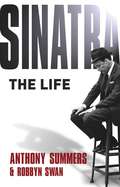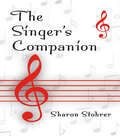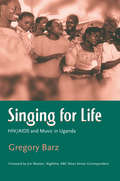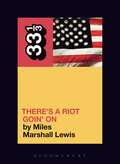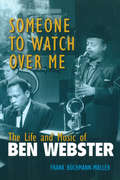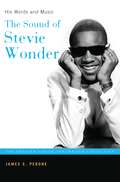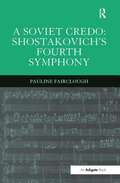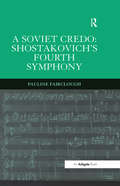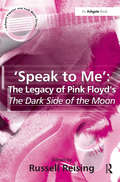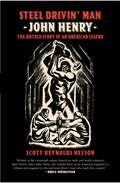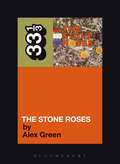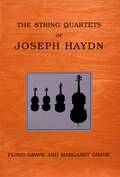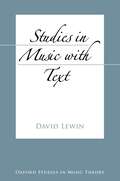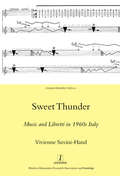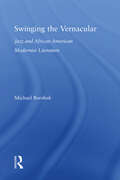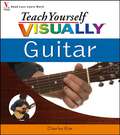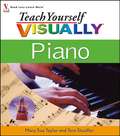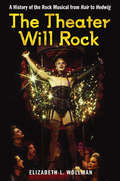- Table View
- List View
Sinatra: The Life
by Anthony Summers Robbyn SwanIn 1941, at age twenty-five, Sinatra told a friend, 'I'm going to be the best singer in the world'. Two years on, the bobbysoxers were already weeping and screaming for him in their thousands. Half a century on Bono defined him as 'the Big Bang of popular music'. 'To hell with the calendar,' a music critic wrote before his death in 1998, 'The day Frank Sinatra dies, the twentieth century is over.'There have been many books about Sinatra, but the last comprehensive biography was Kitty Kelly's HIS WAY, published in 1986. it has taken renowned biographer Anthony Summers years to research this new biography, which promises to be the definitive story of a musical and film career spanning six decades. In this massively documented book, meticulous investigation is coupled with sensitivity to examine every aspect of Sinatra's life, public and private, from his obscure beginnings in an immigrant neighborhood in Jersey City to his twilight years as a living legend in Palm Springs. It tells the human story of an American icon who was irresistible to women and who was plagued throughout his life by scandal and hints of links with the Mafia. In this book, Summers finally uncovers the whole truth.
The Singer's Companion
by Sharon L. Stohrer"The Singer’s Companion" provides both beginning and advanced students of singing with a basic, reliable, and readable introduction to the many issues focusing on training and maintaining a healthy voice. It covers all the fundamental issues faced by vocalists in all styles of music, including how to find a good teacher, work with a score, audition, and perform. Stohrer has written an essential text for students of singing, offering up-to-date, accurate, and accessible information that will be invaluable to singers and their teachers.
The Singer's Companion
by Sharon L. Stohrer"The Singer’s Companion" provides both beginning and advanced students of singing with a basic, reliable, and readable introduction to the many issues focusing on training and maintaining a healthy voice. It covers all the fundamental issues faced by vocalists in all styles of music, including how to find a good teacher, work with a score, audition, and perform. Stohrer has written an essential text for students of singing, offering up-to-date, accurate, and accessible information that will be invaluable to singers and their teachers.
Singing For Life: HIV/AIDS and Music in Uganda
by Gregory BarzFirst Published in 2006. Routledge is an imprint of Taylor & Francis, an informa company.
Singing For Life: HIV/AIDS and Music in Uganda
by Gregory BarzFirst Published in 2006. Routledge is an imprint of Taylor & Francis, an informa company.
Sly and the Family Stone's There's a Riot Goin' On (33 1/3)
by Miles Marshall LewisThe story behind the making of the album that signaled the descent of Sylvester Sly Stone Stewart into a haze of drug addiction and delirium is captivating enough for the cinema. In the spacious attic of a Beverly Hills mansion belonging to John and Michelle Phillips (of the Mamas and the Papas) during the fall of 1970, Sly Stone began recording his follow-up to 1969's "Stand!" the most popular album of his band's career.
Someone to Watch Over Me: The Life and Music of Ben Webster (Jazz Perspectives)
by Frank Büchmann-MøllerFor a half century, Ben Webster, one of the "big three" of swing tenors-along with Coleman Hawkins and Lester Young-was one of the best-known and most popular saxophonists. Early in his career, Webster worked with many of the greatest orchestras of the time, including those led by Willie Bryant, Cab Calloway, Benny Carter, Fletcher Henderson, Andy Kirk, Bennie Moten, and Teddy Wilson. In 1940 Webster became Duke Ellington's first major tenor soloist, and during the next three years he played on many famous recordings, including "Cotton Tail." Someone to Watch Over Me tells, for the first time, the complete story of Ben Webster's brilliant and troubled career. For this comprehensive study of Webster, author Frank Büchmann-Møller interviewed more than fifty people in the United States and Europe, and he includes numerous translated excerpts from European periodicals and newspapers, none previously available in English. In addition, the author studies every known Webster recording and film, including many private recordings from Webster's home collection not available to the public. Exhaustively researched, this is a much needed and long overdue study of the life and music of one of jazz's most important artists.
The Sound of Stevie Wonder: His Words and Music (The Praeger Singer-Songwriter Collection)
by James E. PeroneSince his professional debut in 1962, Stevie Wonder has recorded sixty-four singles that have made the Billboard top 100, including ten that reached number one. Wonder was one of the first Motown artists to have complete control over the writing, arranging, and recording of his songs, and achieved that stature before he was 20 years old. He has won 17 Grammy awards, was elected to the Rock and Roll Hall of Fame in 1989, and earned the Grammy's Lifetime Achievement Award in 1996. Equally important, his work as a producer, arranger, and instrumentalist on other artists' recordings has put him in the highest rank of musical collaborators. This is the first work of criticism on this important documentarian of American life, as well as the introductory volume in The Praeger Singer-Songwriter Collection. Through a combination of biography and critical analysis, James Perone's groundbreaking new book reveals the many ways in which Stevie Wonder's body of work emerged, developed, reflected its time, and influenced myriad other artists.After revealing the social, cultural, and political context of Wonder's work, the book provides detailed analysis of his compositions and recordings, with a focus on both his well-known songs and those known only to his hardcore fans. The volume also contains discussions of cover versions of Wonder's compositions, a discography of his recordings, a song title index, an annotated bibliography, and a general index.
A Soviet Credo: Shostakovich's Fourth Symphony
by Pauline FaircloughComposed in 1935-36 and intended to be his artistic 'credo', Shostakovich's Fourth Symphony was not performed publicly until 1961. Here, Dr Pauline Fairclough tackles head-on one of the most significant and least understood of Shostakovich's major works. She argues that the Fourth Symphony was radically different from its Soviet contemporaries in terms of its structure, dramaturgy, tone and even language, and therefore challenged the norms of Soviet symphonism at a crucial stage of its development. With the backing of prominent musicologists such as Ivan Sollertinsky, the composer could realistically have expected the premiere to have taken place, and may even have intended the symphony to be a model for a new kind of 'democratic' Soviet symphonism. Fairclough meticulously examines the score to inform a discussion of tonal and thematic processes, allusion, paraphrase and reference to musical types, or intonations. Such analysis is set deeply in the context of Soviet musical culture during the period 1932-36, involving Shostakovich's contemporaries Shebalin, Myaskovsky, Kabalevsky and Popov. A new method of analysis is also advanced here, where a range of Soviet and Western analytical methods are informed by the theoretical work of Shostakovich's contemporaries Viktor Shklovsky, Boris Tomashevsky, Mikhail Bakhtin and Ivan Sollertinsky, together with Theodor Adorno's late study of Mahler. In this way, the book will significantly increase an understanding of the symphony and its context.
A Soviet Credo: Shostakovich's Fourth Symphony (PDF)
by Pauline FaircloughComposed in 1935-36 and intended to be his artistic 'credo', Shostakovich's Fourth Symphony was not performed publicly until 1961. Here, Dr Pauline Fairclough tackles head-on one of the most significant and least understood of Shostakovich's major works. She argues that the Fourth Symphony was radically different from its Soviet contemporaries in terms of its structure, dramaturgy, tone and even language, and therefore challenged the norms of Soviet symphonism at a crucial stage of its development. With the backing of prominent musicologists such as Ivan Sollertinsky, the composer could realistically have expected the premiere to have taken place, and may even have intended the symphony to be a model for a new kind of 'democratic' Soviet symphonism. Fairclough meticulously examines the score to inform a discussion of tonal and thematic processes, allusion, paraphrase and reference to musical types, or intonations. Such analysis is set deeply in the context of Soviet musical culture during the period 1932-36, involving Shostakovich's contemporaries Shebalin, Myaskovsky, Kabalevsky and Popov. A new method of analysis is also advanced here, where a range of Soviet and Western analytical methods are informed by the theoretical work of Shostakovich's contemporaries Viktor Shklovsky, Boris Tomashevsky, Mikhail Bakhtin and Ivan Sollertinsky, together with Theodor Adorno's late study of Mahler. In this way, the book will significantly increase an understanding of the symphony and its context.
A Soviet Credo: Shostakovich's Fourth Symphony
by Pauline FaircloughComposed in 1935-36 and intended to be his artistic 'credo', Shostakovich's Fourth Symphony was not performed publicly until 1961. Here, Dr Pauline Fairclough tackles head-on one of the most significant and least understood of Shostakovich's major works. She argues that the Fourth Symphony was radically different from its Soviet contemporaries in terms of its structure, dramaturgy, tone and even language, and therefore challenged the norms of Soviet symphonism at a crucial stage of its development. With the backing of prominent musicologists such as Ivan Sollertinsky, the composer could realistically have expected the premiere to have taken place, and may even have intended the symphony to be a model for a new kind of 'democratic' Soviet symphonism. Fairclough meticulously examines the score to inform a discussion of tonal and thematic processes, allusion, paraphrase and reference to musical types, or intonations. Such analysis is set deeply in the context of Soviet musical culture during the period 1932-36, involving Shostakovich's contemporaries Shebalin, Myaskovsky, Kabalevsky and Popov. A new method of analysis is also advanced here, where a range of Soviet and Western analytical methods are informed by the theoretical work of Shostakovich's contemporaries Viktor Shklovsky, Boris Tomashevsky, Mikhail Bakhtin and Ivan Sollertinsky, together with Theodor Adorno's late study of Mahler. In this way, the book will significantly increase an understanding of the symphony and its context.
A Soviet Credo: Shostakovich's Fourth Symphony
by Pauline FaircloughComposed in 1935-36 and intended to be his artistic 'credo', Shostakovich's Fourth Symphony was not performed publicly until 1961. Here, Dr Pauline Fairclough tackles head-on one of the most significant and least understood of Shostakovich's major works. She argues that the Fourth Symphony was radically different from its Soviet contemporaries in terms of its structure, dramaturgy, tone and even language, and therefore challenged the norms of Soviet symphonism at a crucial stage of its development. With the backing of prominent musicologists such as Ivan Sollertinsky, the composer could realistically have expected the premiere to have taken place, and may even have intended the symphony to be a model for a new kind of 'democratic' Soviet symphonism. Fairclough meticulously examines the score to inform a discussion of tonal and thematic processes, allusion, paraphrase and reference to musical types, or intonations. Such analysis is set deeply in the context of Soviet musical culture during the period 1932-36, involving Shostakovich's contemporaries Shebalin, Myaskovsky, Kabalevsky and Popov. A new method of analysis is also advanced here, where a range of Soviet and Western analytical methods are informed by the theoretical work of Shostakovich's contemporaries Viktor Shklovsky, Boris Tomashevsky, Mikhail Bakhtin and Ivan Sollertinsky, together with Theodor Adorno's late study of Mahler. In this way, the book will significantly increase an understanding of the symphony and its context.
'Speak to Me': The Legacy of Pink Floyd's The Dark Side of the Moon
by Russell ReisingThe endurance of Pink Floyd's The Dark Side of the Moon on the Billboard Top 100 Chart is legendary, and its continuing sales and ongoing radio airplay ensure its inclusion on almost every conceivable list of rock's greatest albums. This collection of essays provides indispensable studies of the monumental 1973 album from a variety of musical, cultural, literary and social perspectives. The development and change of the songs is considered closely, from the earliest recordings through to the live, filmed performance at London's Earls Court in 1994. The band became almost synonymous with audio-visual innovations, and the performances of the album at live shows were spectacular moments of mass-culture although Roger Waters himself spoke out against such mass spectacles. The band's stage performances of the album serve to illustrate the multifaceted and complicated relationship between modern culture and technology. The album is therefore placed within the context of developments in late 1960s/early 1970s popular music, with particular focus on the use of a variety of segues between tracks which give the album a multidimensional unity that is lacking in Pink Floyd's later concept albums. Beginning with 'Breathe' and culminating in 'Eclipse', a tonal and motivic coherence unifies the structure of this modern song cycle. The album is also considered in the light of modern day 'tribute' bands, with a discussion of the social groups who have the strongest response to the music being elaborated alongside the status of mediated representations and their relation to the 'real' Pink Floyd.
'Speak to Me': The Legacy of Pink Floyd's The Dark Side of the Moon
by Russell ReisingThe endurance of Pink Floyd's The Dark Side of the Moon on the Billboard Top 100 Chart is legendary, and its continuing sales and ongoing radio airplay ensure its inclusion on almost every conceivable list of rock's greatest albums. This collection of essays provides indispensable studies of the monumental 1973 album from a variety of musical, cultural, literary and social perspectives. The development and change of the songs is considered closely, from the earliest recordings through to the live, filmed performance at London's Earls Court in 1994. The band became almost synonymous with audio-visual innovations, and the performances of the album at live shows were spectacular moments of mass-culture although Roger Waters himself spoke out against such mass spectacles. The band's stage performances of the album serve to illustrate the multifaceted and complicated relationship between modern culture and technology. The album is therefore placed within the context of developments in late 1960s/early 1970s popular music, with particular focus on the use of a variety of segues between tracks which give the album a multidimensional unity that is lacking in Pink Floyd's later concept albums. Beginning with 'Breathe' and culminating in 'Eclipse', a tonal and motivic coherence unifies the structure of this modern song cycle. The album is also considered in the light of modern day 'tribute' bands, with a discussion of the social groups who have the strongest response to the music being elaborated alongside the status of mediated representations and their relation to the 'real' Pink Floyd.
Steel Drivin' Man: John Henry, The Untold Story of an American Legend
by Scott Reynolds NelsonThe ballad "John Henry" is the most recorded folk song in American history and John Henry--the mighty railroad man who could blast through rock faster than a steam drill--is a towering figure in our culture. In Steel Drivin' Man, Scott Reynolds Nelson recounts the true story of the man behind the iconic American hero, telling the poignant tale of a young Virginia convict who died working on one of the most dangerous enterprises of the time, the first rail route through the Appalachian Mountains. Using census data, penitentiary reports, and railroad company reports, Nelson reveals how John Henry, victimized by Virginia's notorious Black Codes, was shipped to the infamous Richmond Penitentiary to become prisoner number 497, and was forced to labor on the mile-long Lewis Tunnel for the C&O railroad. Equally important, Nelson masterfully captures the life of the ballad of John Henry, tracing the song's evolution from the first printed score by blues legend W. C. Handy, to Carl Sandburg's use of the ballad to become the first "folk singer," to the upbeat version by Tennessee Ernie Ford. Attractively illustrated with numerous images, Steel Drivin' Man offers a marvelous portrait of a beloved folk song--and a true American legend.
The Stone Roses' The Stone Roses (33 1/3)
by Alex GreenThe Stone Roses shows a band sizzling with skill, consumed with drive and aspiration and possessing an almost preternatural mastery of the pop paradigm. This book explores the political and cultural zeitgeist of England in 1989, and attempts to apprehend the magic ingredients that made The Stone Roses such a special album.
The String Quartets of Joseph Haydn
by Floyd Grave Margaret GraveRenowned music historians Floyd and Margaret Grave present a fresh perspective on a comprehensive survey of the works. This thorough and unique analysis offers new insights into the creation of the quartets, the wealth of musical customs and conventions on which they draw, the scope of their innovations, and their significance as reflections of Haydn's artistic personality. Each set of quartets is characterized in terms of its particular mix of structural conventions and novelties, stylistic allusions, and its special points of connection with other opus groups in the series. Throughout the book, the authors draw attention to the boundless supply of compositional strategies by which Haydn appears to be continually rethinking, reevaluating, and refining the quartet's potentials. They also lucidly describe Haydn's famous penchant for wit, humor, and compositional artifice, illuminating the unexpected connections he draws between seemingly unrelated ideas, his irony, and his lightning bolts of surprise and thwarted expectation. Approaching the quartets from a variety of vantage points, the authors correct many prevailing assumptions about convention, innovation, and developing compositional technique in the music of Haydn and his contemporaries.
Studies in Music with Text (Oxford Studies in Music Theory)
by David LewinThroughout his career, David Lewin labored to make even the most abstract theory speak to the experience of the ordinary listener. This book combines many of Lewin's classic articles on song and opera with newly drafted chapters on songs of Brahms, Robert Schumann, Clara Schumann, and Milton Babbitt. Bound together by Lewin's cogent insight, the resulting collection constitutes a major statement concerning the methodological problems associated with interpretation of texted music.
Sweet Thunder: Music and Libretti in 1960s Italy
by Vivienne Suvini-Hand"Italian music of the 1960s is one of the most unjustly neglected areas in the arena of twentieth-century classical music. This volume pays tribute to the astounding complexity of the music and libretti of five vocal compositions by leading experimental composers of the decade: Luigi Dallapiccola, Bruno Maderna, Luciano Berio, Giacomo Manzoni, and Armando Gentilucci. It highlights how the 'difficult' and unconventional methods of composition employed by these artists - dodecaphony, total serialism, Webernian minimalist techniques, aleatory and electronic music - displayed a refusal to compete with the market-place values of Italy's new capitalist society. At the same time, the libretti's collage arrangement of a plethora of European and Oriental literary sources dating from the sixteenth century BC onwards, reflected the contemporary Neo-avant-garde rejection of conventional literary practice, and their preference for 'organised disorder', in Umberto Eco's phrase."
Sweet Thunder: Music and Libretti in 1960s Italy
by Vivienne Suvini-Hand"Italian music of the 1960s is one of the most unjustly neglected areas in the arena of twentieth-century classical music. This volume pays tribute to the astounding complexity of the music and libretti of five vocal compositions by leading experimental composers of the decade: Luigi Dallapiccola, Bruno Maderna, Luciano Berio, Giacomo Manzoni, and Armando Gentilucci. It highlights how the 'difficult' and unconventional methods of composition employed by these artists - dodecaphony, total serialism, Webernian minimalist techniques, aleatory and electronic music - displayed a refusal to compete with the market-place values of Italy's new capitalist society. At the same time, the libretti's collage arrangement of a plethora of European and Oriental literary sources dating from the sixteenth century BC onwards, reflected the contemporary Neo-avant-garde rejection of conventional literary practice, and their preference for 'organised disorder', in Umberto Eco's phrase."
Swinging the Vernacular: Jazz and African American Modernist Literature
by Michael BorshukThis book looks at the influence of jazz on the development of African American modernist literature over the 20th century, with a particular attention to the social and aesthetic significance of stylistic changes in the music.
Swinging the Vernacular: Jazz and African American Modernist Literature
by Michael BorshukThis book looks at the influence of jazz on the development of African American modernist literature over the 20th century, with a particular attention to the social and aesthetic significance of stylistic changes in the music.
Teach Yourself VISUALLY Guitar
by Charles KimDo you learn faster by seeing and doing than by wading through tedious instructions? Then pick up a guitar and start strumming! Teach Yourself VISUALLY Guitar shows you the basics—photo by photo and note by note. You begin with basic chords and techniques and progress through suspensions, bass runs, hammer-ons, and barre chords. As you learn to read chord charts, tablature, and lead sheets, you can play any number of songs, from rock to folk to country. The chord chart and scale appendices are ready references for use long after you master the basics. Concise two-page lessons show you all the steps to a skill and are ideal for quick review Each skill, chord, or technique is clearly described Detailed color photos demonstrate proper fingering and technique Concise and understandable instructions accompany each photo Helpful tips provide additional guidance
Teach Yourself VISUALLY Piano
by Mary Sue Taylor Tere Stouffer DrenthWant to go beyond "Chopsticks?" This visual guide to tickling the ivories will show you the way. By Chapter 2, you'll be playing simple pieces and practicing scales. You'll progress from getting familiar with notes, symbols, and keys to playing basic chords and reading music like a pro. Without getting bogged down in boring theory, you'll learn what you need to know and enjoy playing as you go! Whether you like Bach or rock, jazz or country, golden oldies or new age, you'll love learning to play the fun, visual way. Concise two-page lessons show you all the crucial skills and are ideal for quick review Each skill, chord, or technique is clearly described Concise and understandable instructions accompany each photo Detailed color photos demonstrate proper fingering technique Helpful tips provide additional guidance
The Theater Will Rock: A History of the Rock Musical, from Hair to Hedwig (Anthropology series)
by Elizabeth Lara WollmanThe tumultuous decade of the 1960s in America gave birth to many new ideas and forms of expression, among them the rock musical. An unlikely offspring of the performing arts, the rock musical appeared when two highly distinctive and American art forms joined onstage in New York City. The Theater Will Rock explores the history of the rock musical, which has since evolved to become one of the most important cultural influences on American musical theater and a major cultural export. Packed with candid commentary by members of New York's vibrant theater community, The Theater Will Rock traces the rock musical's evolution over nearly fifty years, in popular productions such as Hair, The Who's Tommy, Jesus Christ Superstar, The Rocky Horror Picture Show, Little Shop of Horrors, Rent, and Mamma Mia!---and in notable flops such as The Capeman. "A much-needed study of the impact of rock music on the musical theater and its resulting challenges, complexities, failures, and successes. Anyone interested in Broadway will learn a great deal from this book." ---William Everett, author of The Musical: A Research Guide to Musical Theatre "This well-written account puts the highs and lows of producing staged rock musicals in New York City into perspective and is well worth reading for the depth of insight it provides." ---Studies in Musical Theatre Elizabeth L. Wollman is Assistant Professor of Music at Baruch College, City University of New York.
